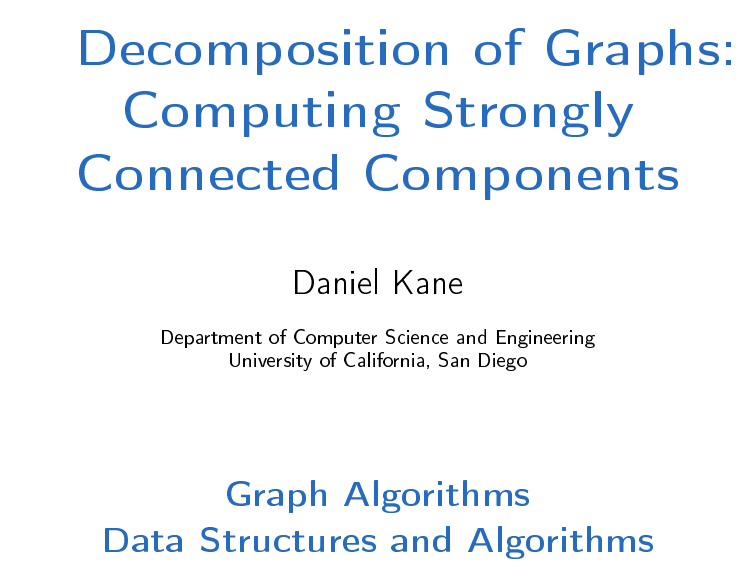
Decomposition of Graphs: Computing Strongly Connected Components Daniel Kane Department of Computer Science and Engineering University of California, San Diego Graph Algorithms Data Structures and Algorithms Learning Objectives Eciently compute the strongly connected components of a directed graph. Last Time Connectivity in directed graphs. Strongly connected components. Metagraph. Problem Strongly Connected Components Input: A directed graph G Output: The strongly connected components of G . Easy Algorithm EasySCC(G ) for each vertex v : run explore(v ) to determine vertices reachable from v for each vertex v : find the u reachable from v that can also reach v these are the SCCs Runtime O(|V |2 + |V ||E |). Want faster. Outline 1 Sink Components 2 Algorithm Sink Components Idea: If v is in a sink SCC, explore(v ) nds vertices reachable from v . This is exactly the SCC of v . Finding Sink Components Need a way to nd a sink SCC. Theorem Theorem If C and C 0 are two strongly connected components with an edge from some vertex of C to some vertex of C 0, then largest post in C bigger than largest post in C 0. Proof Cases: Visit C before visit C 0 Visit C 0 before visit C Case I Visit C rst. Can reach everything in C 0 from C . Explore all of C 0 while exploring C . C has largest post. Case II Visit C 0 rst. Cannot reach C from C 0 Must nish exploring C 0 before exploring C C has largest post. Conclusion The vertex with the largest postorder number is in a source component! Problem: We wanted a sink component. Reverse Graph Let G R be the graph obtained from G by reversing all of the edges. Reverse Graph Components G R and G have same SCCs. Source components of G R are sink components of G . Find sink components of G by running DFS on G R . Problem Which of the following is true? The vertex with largest postorder in G R is in a sink SCC of G . The vertex with the largest preorder in G is in a sink SCC of G . The vertex with the smallest postorder in G is in a sink SCC of G . Solution Which of the following is true? The vertex with largest postorder in G R is in a sink SCC of G . The vertex with the largest preorder in G is in a sink SCC of G . The vertex with the smallest postorder in G is in a sink SCC of G . Outline 1 Sink Components 2 Algorithm Basic Algorithm SCCs(G ) run DFS(G R ) let v have largest post number run Explore(v ) vertices found are first SCC Remove from G and repeat Example Example Example Example Example Example Example Example Example Example Example Improvement Don't need to rerun DFS on G R . Largest remaining post number comes from sink component. New Algorithm SCCs(G ) Run DFS(G R ) for v ∈ V in reverse postorder: if not visited(v ): Explore(v ) mark visited vertices as new SCC Example Example Example Example Example Example Example Example Runtime Essentially DFS on G R and then on G . Runtime O(|V | + |E |).




